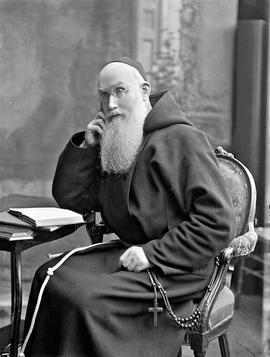File relating to the commemoration of Fr. Theobald Mathew OSFC at the 1902 Cork International Exhibition. Proposed by Edward Fitzgerald, Lord Mayor of Cork, this exhibition and fair showcased many facets of the industrial revival in Ireland. The exhibition included a pavilion devoted to the life and work of Fr. Mathew. The installation of a Father Mathew Pavilion at the exhibition was primarily the result of work done by Fr. Thomas Dowling OSFC (1874-1951). The Exhibition Pavilion was designed by James F. McMullen, architect. The file includes:
• Letters relating to the loan of exhibits, temperance souvenirs, personal effects, paintings and mementos displayed in the Father Mathew Pavilion at the exhibition. Correspondents include Fr. Thomas Dowling OSFC, Fr. Paul Neary OSFC, Fr. Mathew’s collateral descendants, J.D. Power, James Nugent, Fr. J. Kane, Parish Priest of Culdaff, Derry, Joshua Baily and William O’Connell.
• Letter from Denis Downey, Dawson Street, Dublin, to Fr. Thomas Dowling OSFC regarding a painting of Fr. Mathew in his possession. Downey adds ‘the late Father Columbus [Maher OSFC] of Church Street with Miss Redmond, the artist, called here and sketched the features for the O’Connell Street Statue, and Father Columbus told me he would purchase the picture as soon as he would be free from debt over the building of the Hall in Church Street’. 24 Jan. 1902.
• Letter from Thomas S. Bowdern, Supreme Council of the Knights of Father Mathew, St. Louis, Missouri, to Fr. Thomas Dowling OSFC thanking him for his kindness in sending ‘souvenirs of the Great Apostle of Temperance’. Bowdern wrote ‘I assure you we appreciate very highly these souvenirs and will hand them down to our successors in the Knights of Father Mathew that in the flight of years they will become even more and more highly prized if such is possible’. Reference is also made to the Knights’ intention to build a statue of Fr. Mathew for the World Fair. ‘As it is the desire to make our statue after the one in Cork I have been asked to write to you to have you inquire whether there is a replica or moulds in existence of the Cork monument’. 24 Feb. 1903.
• Copybook containing notes on the provenance of many of the items displayed in the Pavilion including temperance certificates and medals, Fr. Mathew’s stole, portrait paintings, Fr. Mathew’s piano and a model of the Capuchin chapel on Blackamoor Lane, Cork.
• Caption panels for objects displayed in the exhibition. Includes descriptions and provenance details for commemorative plates, teapots and other artefacts associated with Fr. Mathew. One of the captions reads: ‘The marble chimney-place at present in Refectory was also left in Father Mathew’s house when he left it, and was presented to Community by Mrs Ryan’.
• Visitors’ Book to the Father Mathew Pavilion at the Cork International Exhibition in 1902. The visitors included Cardinal Michael Logue, Archbishop of Armagh. A note on the final page by Fr. Thomas Dowling OSFC reads ‘No. of visitors over 4,500’.
• Copy prints showing Fr. Thomas Dowling OSFC outside the Father Mathew Pavilion at the exhibition in 1902. The other print shows the interior of the Pavilion with various artefacts associated with Fr. Mathew on display.

